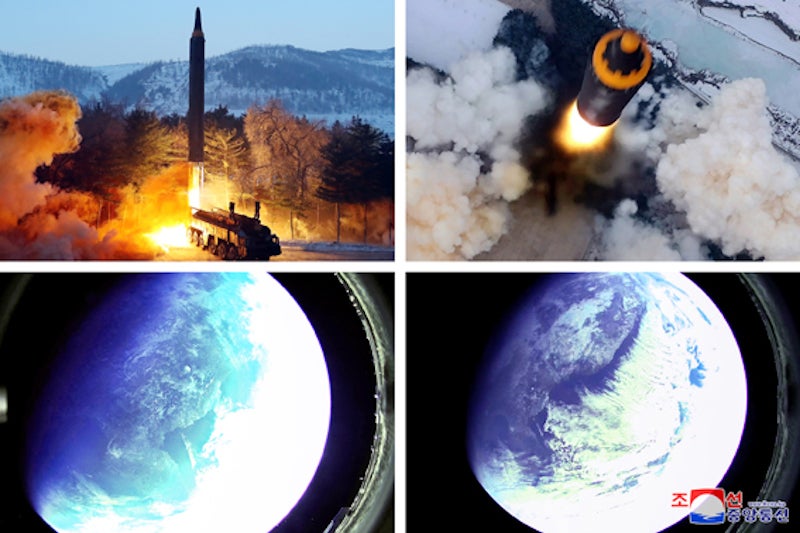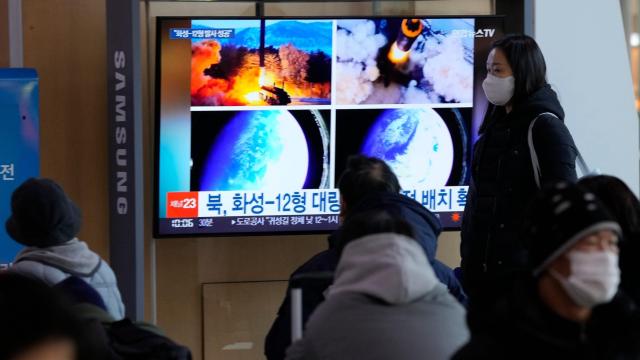An apparently successful weapons test on Sunday included a camera mounted onto the warhead of a North Korean intermediate-range ballistic missile. The new photos of Earth from space seem pleasant enough, but they’re meant to convey a message about the country’s growing military power and reach.
The Hwasong-12 ground-to-ground ballistic missile launched from North Korea’s Jagang Province on January 30, state-owned KCNA news agency announced earlier this week. This is the first test of a Hwasong-12 since 2017, so Sunday’s exercise could represent a resumption of North Korea’s medium-range missile program.
KCNA said the missile was launched by the “highest-angle launch system” and sent “toward the waters of the East Sea of Korea in consideration of the security of neighbouring countries.” By shooting the missile into space at such a high angle, North Korean officials were hoping to “verify the overall accuracy of the weapon system” and test its capabilities. The missile ascended to a height of 2,000 km and travelled some 800 km before splashing into the sea between the Korean peninsula and Japan, according to the Japan Times.

As the Associated Press reports, the Hwasong-12, when fired along a normal trajectory, can travel 4,500 km. This nuclear-capable intermediate-range missile is thus capable of reaching Japan, the U.S. Pacific territory of Guam, and the westernmost portions of Alaska’s Aleutian Islands.
North Korea’s Academy of Defence Science provided four images of the test, two of which were taken from space by a camera mounted onto the missile warhead. The photos, though unverified, are a message to Washington and other rivals, as the test “confirmed the accuracy, security and effectiveness of the operation of the Hwasong 12-type weapon system under production,” said KCNA.
This marks the seventh missile launch from North Korea this year. The most recent launch is a potential signal that the country’s self-imposed pause on long-range tests has come to an end and that there’s more to come. The Japan Times says the missile test is a possible sign that North Korea is set to renew nuclear tests or launch intercontinental ballistic missiles (ICBMs) capable of reaching the U.S. mainland.
Many possible reasons exist for why North Korea has suddenly gotten busy after five years of relative calm, but a quick history lesson from A. B. Abrams of the Diplomat provides some important context:
The Hwasong-12 occupies an important role in the KPA’s arsenal, the doctrine and priorities of which continue to be very heavily influenced by the experience and historical memory of the Korean War. In the early 1950s, the United States Air Force launched a firebombing campaign across North Korea from the safety of bases in Japan, which were well beyond the range of any KPA asset to retaliate. That weakness left North Korea effectively helpless in the face of three years of continuous bombardment, with more ordinance dropped on the country by U.S. forces than on the entire Japanese Empire during the Pacific War.
The new test is likely the result of steady improvements to Hwasong-12, which was tested three times in 2017. This also appears to be the most powerful version of the missile yet.
The launch of this ballistic missile could also be an attempt by Kim Jong-un, the country’s ruthless totalitarian dictator, to finally get sanctions removed (or eased) and to facilitate nuclear talks. Leif-Eric Easley from Ewha University in Seoul told the AP that North Korea is “launching a frenzy of missiles before the start of the Beijing Olympics, mostly as military modernisation efforts,” and that Pyongyang “wants to remind Washington and Seoul that trying to topple it would be too costly.”
Denuclearization talks between the U.S. and North Korea are at a stalemate given disagreements over the easing of sanctions and the extent to which North Korea is being asked to relinquish its nuclear capabilities. President Joe Biden has expressed an interest in engaging with North Korea on the diplomatic front, but there doesn’t seem to be much progress in this area.
